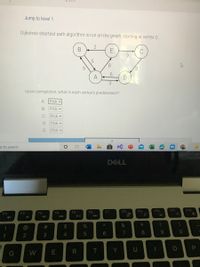
Database System Concepts
7th Edition
ISBN: 9780078022159
Author: Abraham Silberschatz Professor, Henry F. Korth, S. Sudarshan
Publisher: McGraw-Hill Education
expand_more
expand_more
format_list_bulleted
Question
thumb_up100%
Can someone please explain it to me ASAP?!!! This is dijkstra’s shortest path

Transcribed Image Text:### Dijkstra's Shortest Path Algorithm
#### Objective:
Understand and apply Dijkstra's shortest path algorithm on a graph, starting at vertex C.
#### Graph Description:
The given graph consists of five vertices (A, B, C, D, E) connected by directed edges with associated weights, illustrating the following connections:
- Vertex B to Vertex E with weight 2.
- Vertex C to Vertex E with weight 5.
- Vertex E to Vertex A with weight 8.
- Vertex A to Vertex B with weight 5.
- Vertex A to Vertex D with weight 6.
- Vertex D to Vertex C with weight 3.
- Vertex D to Vertex E with weight 5.
- Vertex B to Vertex A with weight 9.
- Vertex B to Vertex D with weight 3.
#### Task:
Upon running Dijkstra's algorithm starting at vertex C, determine the predecessor of each vertex upon completion.
#### Implementation:
1. Initialize the distance to the starting vertex (C) as 0 and all other distances as infinity.
2. Mark all vertices as unvisited. Set the initial vertex as the current vertex.
3. For the current vertex, consider all its unvisited neighbors and calculate their tentative distances.
4. Update the shortest distance if the calculated tentative distance is less than the known distance.
5. After considering all neighbors of the current vertex, mark the current vertex as visited.
6. Repeat the process for the vertex with the smallest tentative distance among the unvisited vertices.
7. Continue until all vertices have been visited.
#### Question:
What is each vertex's predecessor upon the completion of Dijkstra's algorithm?
Choices:
A:
- Pick
- B
- C
- D
- E
B:
- Pick
- A
- B
- C
- D
C:
- Pick
- A
- B
- C
- D
D:
- Pick
- A
- B
- C
- E
E:
- Pick
- A
- B
- C
- D
Select the predecessor for each vertex to complete the query.
Expert Solution
This question has been solved!
Explore an expertly crafted, step-by-step solution for a thorough understanding of key concepts.
This is a popular solution
Trending nowThis is a popular solution!
Step by stepSolved in 2 steps

Knowledge Booster
Learn more about
Need a deep-dive on the concept behind this application? Look no further. Learn more about this topic, computer-science and related others by exploring similar questions and additional content below.Similar questions
- How Kruskal's Algorithm Works?arrow_forwardHow many bit strings are there of length n where n is a nonnegative integer? I am not sure if i am overthinking this but would it be 2n? or is there more to the solution?arrow_forwardfind the shortest distance from point A to point I using pythonarrow_forward
- Question 37 How many bit strings of length six both begin and end with a 0? How do you solve this problem?arrow_forwardCan we take a scientific approach to solving the Hamming codes that fix errors? Explainarrow_forwardConsider all bit (binary digit) strings of length 12. How many begin with 110? How many begin with 11 and end with 10? How many begin with 11 or end with 10? How many have exactly four 1s?arrow_forward
arrow_back_ios
arrow_forward_ios
Recommended textbooks for you
 Database System ConceptsComputer ScienceISBN:9780078022159Author:Abraham Silberschatz Professor, Henry F. Korth, S. SudarshanPublisher:McGraw-Hill Education
Database System ConceptsComputer ScienceISBN:9780078022159Author:Abraham Silberschatz Professor, Henry F. Korth, S. SudarshanPublisher:McGraw-Hill Education Starting Out with Python (4th Edition)Computer ScienceISBN:9780134444321Author:Tony GaddisPublisher:PEARSON
Starting Out with Python (4th Edition)Computer ScienceISBN:9780134444321Author:Tony GaddisPublisher:PEARSON Digital Fundamentals (11th Edition)Computer ScienceISBN:9780132737968Author:Thomas L. FloydPublisher:PEARSON
Digital Fundamentals (11th Edition)Computer ScienceISBN:9780132737968Author:Thomas L. FloydPublisher:PEARSON C How to Program (8th Edition)Computer ScienceISBN:9780133976892Author:Paul J. Deitel, Harvey DeitelPublisher:PEARSON
C How to Program (8th Edition)Computer ScienceISBN:9780133976892Author:Paul J. Deitel, Harvey DeitelPublisher:PEARSON Database Systems: Design, Implementation, & Manag...Computer ScienceISBN:9781337627900Author:Carlos Coronel, Steven MorrisPublisher:Cengage Learning
Database Systems: Design, Implementation, & Manag...Computer ScienceISBN:9781337627900Author:Carlos Coronel, Steven MorrisPublisher:Cengage Learning Programmable Logic ControllersComputer ScienceISBN:9780073373843Author:Frank D. PetruzellaPublisher:McGraw-Hill Education
Programmable Logic ControllersComputer ScienceISBN:9780073373843Author:Frank D. PetruzellaPublisher:McGraw-Hill Education

Database System Concepts
Computer Science
ISBN:9780078022159
Author:Abraham Silberschatz Professor, Henry F. Korth, S. Sudarshan
Publisher:McGraw-Hill Education

Starting Out with Python (4th Edition)
Computer Science
ISBN:9780134444321
Author:Tony Gaddis
Publisher:PEARSON

Digital Fundamentals (11th Edition)
Computer Science
ISBN:9780132737968
Author:Thomas L. Floyd
Publisher:PEARSON

C How to Program (8th Edition)
Computer Science
ISBN:9780133976892
Author:Paul J. Deitel, Harvey Deitel
Publisher:PEARSON

Database Systems: Design, Implementation, & Manag...
Computer Science
ISBN:9781337627900
Author:Carlos Coronel, Steven Morris
Publisher:Cengage Learning

Programmable Logic Controllers
Computer Science
ISBN:9780073373843
Author:Frank D. Petruzella
Publisher:McGraw-Hill Education